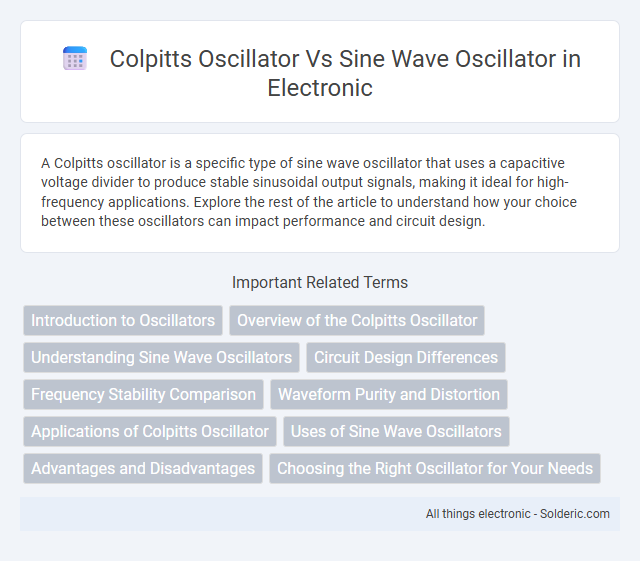A Colpitts oscillator is a specific type of sine wave oscillator that uses a capacitive voltage divider to produce stable sinusoidal output signals, making it ideal for high-frequency applications. Explore the rest of the article to understand how your choice between these oscillators can impact performance and circuit design.
Comparison Table
| Feature | Colpitts Oscillator | Sine Wave Oscillator |
|---|---|---|
| Oscillation Type | LC oscillator (uses capacitive voltage divider) | General oscillator producing pure sine wave output |
| Frequency Determination | Determined by inductor (L) and capacitors (C1, C2) in tank circuit | Depends on specific oscillator design (LC, RC, crystal) |
| Feedback Method | Capacitive voltage divider provides feedback | Varies; can be capacitive, inductive, or using active elements |
| Common Applications | RF signal generation, communication circuits | Audio signal generation, waveform synthesis, testing |
| Stability | Moderate frequency stability | Depends on design; crystal oscillators have high stability |
| Complexity | Simple circuit with fewer components | Varies; can be simple or complex |
| Output Waveform | Pure sinusoidal waveform | Pure sine wave output |
Introduction to Oscillators
Oscillators generate continuous waveforms essential for communication and signal processing. The Colpitts oscillator specifically uses a capacitive voltage divider to produce a stable sine wave output, making it ideal for high-frequency applications. Your choice between a Colpitts oscillator and a general sine wave oscillator depends on factors like frequency stability, circuit complexity, and signal purity requirements.
Overview of the Colpitts Oscillator
The Colpitts oscillator is a type of sine wave oscillator that generates smooth, stable sinusoidal signals using a capacitive voltage divider in its feedback network. Its hallmark is the use of two capacitors in series, which establish the frequency of oscillation by determining the resonant frequency of the LC circuit. Known for low harmonic distortion and ease of frequency tuning, the Colpitts oscillator is widely used in RF signal generation and communication systems.
Understanding Sine Wave Oscillators
Sine wave oscillators generate smooth, periodic waveforms essential for communication and signal processing applications, with the Colpitts oscillator being a popular type due to its simplicity and frequency stability. The Colpitts oscillator uses a capacitive voltage divider in its feedback network to produce a pure sine wave, offering low distortion and consistent amplitude. Your choice between different sine wave oscillators depends on factors like frequency range, stability, and circuit complexity.
Circuit Design Differences
A Colpitts oscillator features a tank circuit utilizing a capacitive voltage divider with two capacitors and an inductor to determine oscillation frequency, whereas a generic sine wave oscillator may employ various feedback networks like RC or LC circuits without a fixed capacitor configuration. The Colpitts design specifically uses a single transistor or FET with the capacitive divider providing the necessary phase shift for sustained oscillations. In contrast, sine wave oscillators encompass diverse topologies including Wien bridge, phase shift, and Hartley oscillators, each distinguished by unique feedback and frequency control mechanisms.
Frequency Stability Comparison
The Colpitts oscillator exhibits superior frequency stability compared to generic sine wave oscillators due to its reliance on a capacitive voltage divider that provides precise control over oscillation frequency. The inherent design of the Colpitts circuit minimizes frequency drift caused by temperature variations and component tolerances, making it ideal for high-frequency applications such as RF signal generation. Sine wave oscillators without such feedback configurations often experience greater frequency instability and phase noise, reducing their effectiveness in precision signal generation tasks.
Waveform Purity and Distortion
The Colpitts oscillator produces a sine wave known for its high waveform purity due to its stable frequency-determining components, minimizing harmonic distortion. In contrast, generic sine wave oscillators may exhibit increased distortion depending on their circuit design and component precision. Selecting a Colpitts oscillator can ensure your signal maintains low harmonic distortion for applications requiring clean and stable sine waves.
Applications of Colpitts Oscillator
Colpitts oscillators are widely used in RF signal generation, communication systems, and frequency synthesis due to their ability to provide stable and low distortion sine wave outputs at high frequencies. These oscillators are preferred in applications requiring precision frequency control, such as in local oscillators for receivers and transmitters or as a clock signal source in microwave circuits. Your choice of a Colpitts oscillator ensures reliable performance for wireless communication, signal modulation, and sensor excitation tasks.
Uses of Sine Wave Oscillators
Sine wave oscillators, including Colpitts oscillators, are widely used in applications requiring stable and pure sinusoidal signals such as radio frequency (RF) signal generation, audio signal synthesis, and function generators. Your choice of a sine wave oscillator depends on parameters like frequency stability, signal purity, and power efficiency, essential for communication systems, waveform generators, and instrumentation. These oscillators are critical in testing, modulation, and timing circuits where precise sine wave output is crucial.
Advantages and Disadvantages
The Colpitts oscillator offers a stable and low-distortion sine wave output, making it ideal for high-frequency applications, but it requires precise capacitor value selection which can complicate tuning. In contrast, sine wave oscillators such as Wien bridge oscillators provide easy frequency control and simpler design but may suffer from lower frequency stability and higher distortion. Your choice depends on whether stability and purity of the signal or design simplicity and adjustability are more critical for your application.
Choosing the Right Oscillator for Your Needs
The Colpitts oscillator, known for its stable frequency and simple design using capacitors and inductors, excels in generating high-frequency sine waves with low distortion, ideal for RF applications. Sine wave oscillators encompass various designs tailored to produce pure sinusoidal signals, offering flexibility for audio, communication, and signal processing tasks. Your choice depends on the required frequency stability, signal purity, and circuit complexity, making the Colpitts oscillator a preferred option for high-frequency precision and general sine wave oscillators suitable for broader, versatile uses.
colpitts oscillator vs sine wave oscillator Infographic

 solderic.com
solderic.com